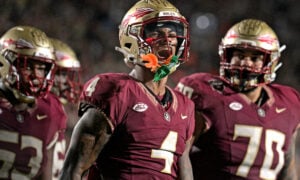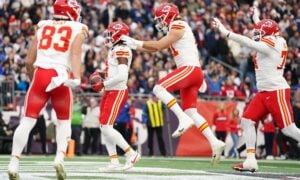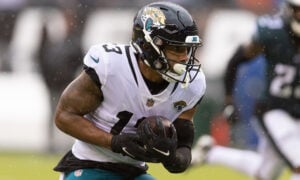2017 College Market Share Report: Wide Receivers
Analyzing film, metrics and reading scouting reports are various methods for dynasty owners preparing for their rookie drafts. It’s a tough process, because even professional scouts whiff on players. We don’t officially get all of the information surrounding these players before they enter the draft, so we have to extrapolate the data as best we can to maximize our player evaluations.
Market share data makes it easier to understand how important a player’s production was to the team’s overall success. Wide receivers who own well over 30 percent of their team’s passing production are considered key contributors to their respected offenses. It’s hard to be successful at the NFL level without being one of the top players in college football.
Unfortunately, not all receivers have the luxury to play in high-powered offenses. Poor quarterback play paired with an offense that exemplifies the run game makes it hard for a receiver to put up video game-like stats. Market share data provides an idea of how important a player is to their offense and paints a portrait of how that player could potentially look like if they played in a high-volume passing attack. Market share statistics gives a different landscape on how to measure a player’s production.
The draft process is like planning for a big trip and the tools we use to evaluate a player is our roadmap. The more routes we have highlighted on our map, the more likely we will reach our destination. The more tools you have to assess a player’s talent, the more likely you will make the right decisions in your rookie, devy and startup drafts.
For the report, I pulled the top 200 receivers in receiving yards, figured out their market share percentages then allocated them by class. By separating the players by class, we get a portrait of the breakout ages for some of the underclassmen. This might help us to decipher which players are producing during the early stages of their career.
Below are the links to the market share reports from the previous two years:
Please remember, the Market Share Report should be used in conjunction with film analysis and other metrics. There are no end-all-be-all metrics, and this report should be used as a reference for a player’s production.
[am4show have=’g1;’ guest_error=’sub_message’ user_error=’sub_message’ ]

Ricky Jeune, WR Georgia Tech
Jeune leads the nation with a 58.79 percent market share. Consider him an outlier in this data set, considering Georgia Tech only passed for just 927 yards during the entire season and Jeune was the team’s leading receiver with 545 yards. He’s a prospect who is worth a look during the draft process.
Michael Gallup, WR Colorado State
Gallup finished his senior season catching 100 passes for 1,413 yards and seven touchdowns. He will be one of the top receivers in the upcoming draft. He’s a polarizing prospect who has caught 2,690 yards and 21 touchdowns in the last two seasons.
DJ Chark, WR LSU
Due to LSU’s run-first offense, Chark wasn’t a mega producer this year. He posted just 874 and three touchdowns, but it was enough to own 33.04 percent of LSU’s passing offense. Chark is another prospect who will be under a microscope during the draft process.
James Washington, WR Oklahoma State
Washington is a remarkable athlete and quite frankly, one of the best wide receivers in the country. He led the nation with 1,549 yards. He also has three straight seasons with over 1,000 yards receiving. Washington will easily be a first-round pick in rookie drafts this spring.
J’Mon Moore, WR Missouri
Moore is an under the radar prospect who could become one of the more lucrative wide receiver prospects in this draft. He finished the season ranked second in the SEC with 1,082 receiving yards. Moore is a highly athletic prospect who can make plays on the ball downfield. He’s going to be trendy option during the draft process.
Allen Lazard, WR Iowa State
Lazard would have been one of the top wide receivers in last year’s draft class, but he elected to return for his senior season. This season he caught 71 passes for 941 yards and ten touchdowns. His biggest moment of the season came when he caught the game-winning 25-yard touchdowns pass to help the Iowa State Cyclones defeat the Oklahoma Sooners 38-31.
Dante Pettis, WR Washington
Pettis is a crowd favorite amongst the draft community and will be one of the most intriguing prospects in this year’s draft. This season he caught 63 passes for 761 and seven touchdowns while owning a 26.34 percent market share of Washington’s passing offense.

D.J Moore, WR Maryland
Moore’s draft stock is already gaining a lot of steam and it should only increase as we get farther into the draft process. This season he caught 80 passes for 1,033 yards and eight touchdowns. He had three games with over 100 yards receiving.
Calvin Ridley, WR Alabama
Ridley was on the previous two market share reports, posting 33.56 percent and 24.38 percent market shares during his freshman and sophomore seasons. This year he managed to catch 63 passes for 967 yards and five touchdowns, equating to a 35.71 percent market share of Alabama’s passing offense. Ridley is one of the top wide receiver prospects in this year’s draft class and will more-than-likely be a first-round pick in the NFL Draft.
Courtland Sutton, WR SMU
Sutton is in the discussion of being the best wide receiver in this draft class. He has the size and athleticism of a prototypical WR1 at the NFL level. This year he caught 68 passes for 1,085 yards and 12 touchdowns while owning a 28.38 percent market share of SMU’s passing offense.
Deontay Burnett, WR USC
Burnett led USC in receiving with 86 balls caught for 1,114 yards and nine touchdowns. He announced a recently that he will be entering the draft and is a prospect who will gather a lot of steam during the draft process.
Simmie Cobbs Jr., WR Indiana
Cobbs is a big physical wide receiver who could carve out a role at the NFL level as a traditional flanker. He didn’t play during his junior season because he was recovering from an ankle surgery that he suffered early in the season. Off-the-field issues could keep him shooting up draft boards.
Christian Kirk, WR Texas A&M
Kirk caught 71 passes for 919 yards and ten touchdowns this season while owning a 28.14 percent market share of the team’s passing offense. He was in the two previous market share reports, producing 30.36 percent and 29.94 percent market shares during his freshman and sophomore seasons. Kirk will be one of the top wide receiver prospects in this year’s draft class.
Deon Cain, WR Clemson
Cain is considered one of the better prospects in this class. He’s been a very popular stash in devy leagues in the last few seasons. This year was his most productive season, catching 58 passes for 734 yards and six touchdowns while owning a 22.26 percent market share of Clemson’s passing production. Keep an eye on him during the draft process, because his stock could significantly increase during draft season.
Auden Tate, WR Florida State
Tate played through injuries this season, which impacted some of his overall production. He still was very productive, catching 40 passes for 548 yards and ten touchdowns while owning a 21.48 percent market share of his team’s passing offense. Even if he falls in the draft, Tate will easily be a hot commodity in rookie drafts due to his talent.
Equanimeous St. Brown, WR Notre Dame
St. Brown did not make it on the market share report, but he’s still one of the top wide receiver prospects in the country. There wasn’t enough volume in Notre Dame’s passing attack to feed high-end production for any of their receivers. On the season, St. Brown caught 33 passes for 515 yards and four touchdowns while owning a 22.14 percent of the team’s passing production.

N’Keal Harry, WR Arizona State
Harry is one of the top wide receivers in college football and he has a bright future in front of him. If he declares, he should be one of the top prospects in next year’s draft class. This year he caught 82 passes for 1,142 and eight touchdowns.
A.J. Brown, WR Ole Miss
Brown led the SEC with 1,215 yards receiving and 11 touchdowns. He is another talented receiver who could be a hot prospect in next year’s draft. Keep an eye on him next year.
Kelvin Harmon, WR North Carolina State
Harmon has the size and athleticism to be the prototypical WR1 at the NFL level. He caught 1,017 yards and four touchdowns this year. He’s a candidate to take college football by storm next year.
Bryan Edwards, WR South Carolina
Edwards is another breakout candidate for next year. He owned 28.38 percent of South Carolina’s passing offense. With another year of development, Edwards could jump to the top of draft boards next year.
Collin Johnson, WR Texas
Johnson is another big wide receiver who could potentially develop into one of the best wide receivers in the country. This year he caught 54 passes for 765 yards and two touchdowns while owning a 22.73 percent market share of Texas’ passing offense.

Tyler Vaughns, WR USC
Vaughns was a four-star prospect who was considered one of the top wide receivers in his recruiting class. This year he caught 57 passes for 809 yards and five touchdowns while owning a 19.33 percent market share of the team’s passing offense. His production should only increase going forward.
Jhamon Ausbon, WR Texas A&M
Ausbon is considered one of the top freshman wide receivers in the country. He had a lot of competition for targets this year at Texas A&M but still managed to own 17.48 percent market share of the team’s passing offense. Don’t be surprised if he develops into the next big thing in college football.
CeeDee Lamb, WR Oklahoma
Is a four-star prospect who has the potential to develop into a mega-productive asset for the Oklahoma Sooners. This year he caught 46 passes for 807 yards and seven touchdowns.
[/am4show]


































































